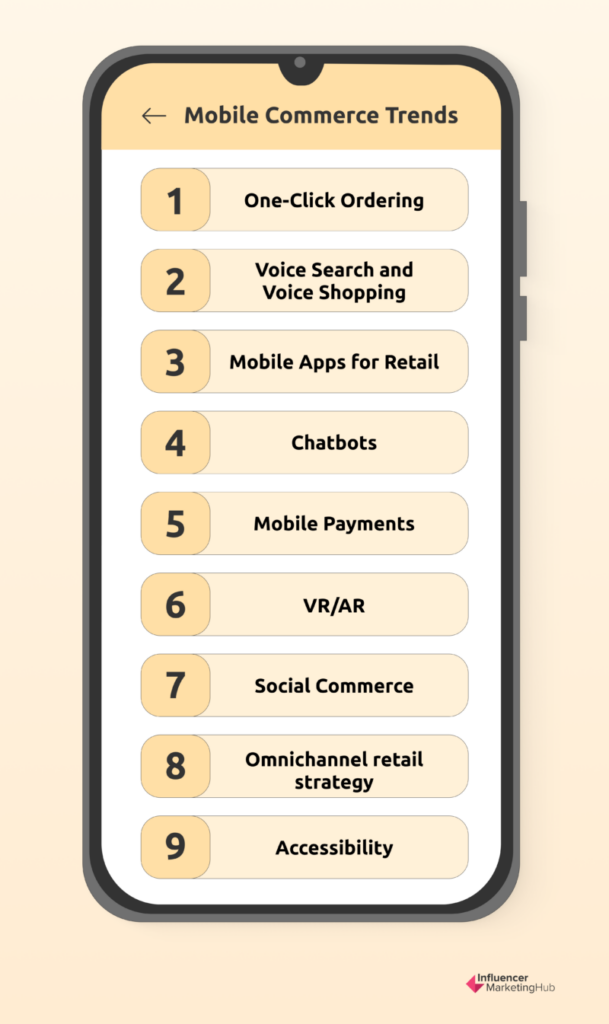No doubt about it—mobile commerce is shaping the present and future of commerce. Mobile commerce, often shortened to m-commerce, is a subfield of eCommerce that refers to wireless or handheld devices for commercial transactions. This includes online shopping, financial transactions, and other types of exchanges of goods and services are done online.
Mobile commerce in the US has been steadily growing in recent years, becoming an essential aspect of how consumers engage with brands and make purchases. Its increasing prevalence means businesses must stay attuned to the latest trends to stay competitive.
Mobile commerce vs eCommerce
The term “eCommerce” encompasses a broader realm of commerce. When we say eCommerce, we mean all transactions done electronically, usually via the Internet. On the other hand, mobile commerce involves electronic transactions performed on mobile devices, such as cell phones and tablets. For instance, if you buy something from Amazon on your desktop, it’s eCommerce, but not mobile commerce. If you purchase it from the Amazon website or app on your mobile phone, it’s mobile commerce.
Top Mobile Commerce Trends in 2025
1. One-Click Ordering
Pioneered (and patented) by Amazon way back in 1999, “1-click” ordering changed the online shopping landscape. One-click ordering simplified how customers shopped for goods on the Amazon website. A customer buying something online for the first time can input their billing, shipping, and payment information on the website one time. Then for future purchases, they can click on a button, and the website remembers their previously entered data. It makes for faster and more seamless transactions, which is suitable for conversions and customer experience.
Amazon’s patent for one-click ordering expired in 2017, so it’s now available for online retailers to use without having to pay licensing fees from Amazon. It’s one of the trends that will define mobile commerce in 2025, as the consumers’ demand is hassle-free online shopping. The impact of one-click ordering on mobile commerce will be more significant, as it’s more difficult for users to input long strings of information on their mobile device than on a desktop computer.
2. Voice Search and Voice Shopping
The rise and popularity of smart speakers have contributed to the increased use of voice shopping. Voice searches and voice shopping use artificial intelligence and voice recognition to enable consumers to transact online more quickly.
According to PWC, 71% of consumers surveyed would instead use a voice assistant to search for something online. While the majority of respondents prefer going to a physical store, shopping online, or using mobile apps over voice shopping, the trend this year is arguably leaning toward more transactions using voice searches and voice shopping. This year, optimize your website for voice search, so you don’t fall behind on this trend.
3. Mobile Apps for Retail
Apps are everywhere nowadays. The Covid-19 pandemic sped up the growth of mobile commerce apps, with the Amazon app leading the pack in the Western markets. In the US, sales from mobile commerce apps accounted for a little more than half of all eCommerce revenue.
The trend we’re seeing right now is that consumers prefer shopping on mobile apps instead of using an Internet browser. So before the market gets saturated with retail mobile apps, it’s best to develop one before your competition gets ahead of you.
If you have a mobile app plus one-click ordering, you’re providing your customers with a hassle-free shopping experience, which is one of the first steps to cultivating loyalty from them.
4. Chatbots
With millions of consumers doing some form of mobile shopping daily, it’s prudent to have some assistance when it comes to customers asking for help.
Chatbots are computer programs that simulate human conversations. Chatbots usually assist consumers in mobile commerce. Online shopping takes away in-store human interactions, but many people still want to talk to someone about a product, ask something specific, or have other queries that need to be addressed in the product description or website. Chatbots help by providing useful basic information to customers and then directing them to an actual person if the question is too complex for a bot to answer.
But why use chatbots? Why not just use real people? Chatbots have the advantage of being available 24/7, so your customers can immediately respond. They can get an immediate reply from a chatbot if their concern can be easily resolved. In addition, if hundreds of people message you in a day, it might become unsustainable for a real person to keep up with everyone’s questions.
5. Mobile Payments
Almost all people still carry cash in their wallets and use either cash or credit card for shopping, but the trend for 2025 is most definitely an increasing number of mobile wallet payments. It’s secure, quick, and accessible.
Even if most of your customers still use credit cards for payment, it’s a good idea to include mobile charges and other alternative payment options. Mobile wallet payments grew tenfold in five years—from $25 billion in 2016 to $275 billion in 2021.
Big players like Apple Pay and Google Pay have added integrations for seamless and contactless transactions, so now is the perfect time to get in on mobile payments.
6. VR/AR
Virtual and augmented reality has been slowly but surely penetrating our everyday lives. No longer confined to the entertainment industry, VR/AR has found its purpose in retail as well.
Some of the big brands that have incorporated VR/AR into their mobile apps include Ikea, Amazon, and Sephora. One of the most popular tools that use VR/AR is allowing the customer to virtually try on products before purchasing, thereby reducing the risk of returns and customer dissatisfaction. On Ikea’s app, the customer can point their phone camera at an area in their home or office. Then, the app will automatically measure the space and provide recommendations for furniture.
7. Social Commerce
Social commerce refers to another subset of eCommerce, where goods and services are bought and sold over social media platforms.
Say you are scrolling through your Instagram feed, and you come across a new product that an online store you are following is launching. If you can buy it directly from Instagram, that is social commerce. No need to click an external link or go to a mobile app to complete a transaction.
This is a trend you should definitely consider, as in 2024, internet users worldwide spent an average of 143 minutes per day on social media. While this is a slight decrease from 151 minutes the previous year, it still represents a significant amount of time and attention that businesses can capitalize on.
8. Omnichannel retail strategy
Omnichannel retail simply means you use multiple channels to sell your products and services. You can have a physical store, a social media presence, a website, a mobile app, or a combination of these. Today’s consumer researches what they want to buy ahead of time, through multiple sources. In fact, even as they are shopping in-store, they might be looking up their options on their smartphone.
Having a retail strategy that encompasses all platforms and channels is the trend for 2025. With the end of the pandemic and the return to physical stores, people now have more options for shopping than ever before. Retailers need to understand that the experience they provide to their customers across different channels should be the same. They cannot treat their online customers differently from their customers who shop in their physical stores.
9. Accessibility
This year, accessibility has come out as one of the top trends in mobile commerce. Thanks to technology, those with limited capabilities can now enjoy more things than they used to. This includes shopping on mobile devices.
Sixty-five percent of customers with some form of disability have abandoned their cart or given up on an online purchase because of accessibility issues. People with disabilities represent a vast global market, so retailers will do well to keep them in mind when designing their mobile websites and apps.
From the layout of the interface to the text size, to audio options for visually impaired people, accessibility options should be prioritized in mobile commerce. Otherwise, we risk alienating a big chunk of the retail market, one whose purchasing power is comparable to the Chinese market.
The Rise of Mobile Commerce
One of the significant factors in the rise of mobile commerce is the widespread availability of smartphones. By 2030, the number of smartphone users in the U.S. is projected to surpass 338 million, further driving mobile commerce growth.
Mobile devices provided clear benefits such as convenience and portability and with the advent of smartphones that had added functionalities, the use of these handheld devices for daily activities and even work-related tasks grew.
As developers began creating more apps for mobile and incorporating well-designed UX and UI interfaces for mobile websites, people started using their smartphones for more than just communication, photography, and games. Many banks hopped in on the mobile revolution, developing their app for mobile banking. Online retailers reached out to their customers via social media, and their loyal markets eagerly embraced this new way of interacting with their favorite brands.
Unsurprisingly, mobile commerce grew significantly during the pandemic, when people were stuck inside their homes. Left with few other options, people turned to mobile commerce to shop for essential goods and services. Website and app developers for retail were forced into fast-tracking the improvement of their mobile apps to cater to the sudden increase in mobile shopping.
Also, a factor in the rise of mobile commerce is the fact that Generation Z, conceivably the most adept at smartphone and tablet usage, is now reaching adulthood. Gen Z is the generation that grew up with the Internet all their life, so using their phones for everything comes naturally for them. Gen Z and millennials are the demographics that are most likely to engage in mobile commerce. As Gen Z starts grows more independent and take on more responsibilities, mobile shopping is their go-to for goods and services.
However, there remain some barriers to mobile commerce. Shopping through your mobile device is convenient, but there are still some concerns over the security of payments, a non-friendly mobile version of a website, and a complicated checkout process. But as we’ve seen, the trends this 2025 point toward improving the customer experience for mobile shopping.
Benefits of Mobile Commerce
Mobile commerce is popular because of a variety of reasons:
1. Convenience and customer experience
We almost always have a mobile device near us, so it’s more convenient for last-minute shopping and researching options. Mobile shopping is also usually better at providing a good customer experience for users since it’s fast, convenient, and interactive.
2. Faster transactions
Another part of giving a good customer experience is speedy transactions and checkout processes. This is especially true for mobile apps, which are generally faster than mobile-friendly websites. Customers appreciate getting through the purchase process quickly and seamlessly, and mobile commerce can provide them with what they need.
3. Location tracking
“Find a store near me” is one of the most significant advantages of mobile commerce. Businesses can direct their customers to their nearest branch, simplifying the purchase process. Inside the store, apps can use GPS to guide customers toward the products they are looking for.
4. Analytics
Unlike in-store purchases, where people come in, buy something, and leave, mobile commerce gives businesses essential insights that can help them in their marketing efforts. You have a customer list with data on who they are, what they bought, how often they visit and make a purchase, their preferred payment method, shipping address, and other meaningful information.
5. Better communication with customers
Mobile commerce promotes direct communication with customers. You can send out personalized ads about sales and product launches, engage with them on social media, and thus cultivate a good working relationship with your target market.





